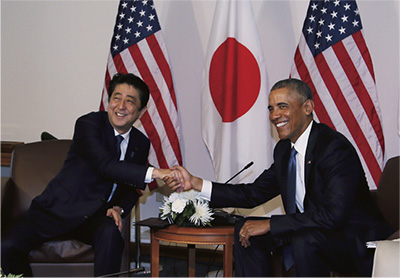Diplomatic Bluebook 2017
Chapter 2
Japan's Foreign Policy that Takes a Panoramic Perspective of the World Map
Section 2 North America
Overview
〈United States〉
Japan and the U.S. are strong allies sharing fundamental values and strategic interests. The Japan-U.S. Alliance is the linchpin of Japan's diplomacy and security, and plays a major role in maintaining the stability and prosperity not only of the Asia-Pacific region but also of the whole world.
In May, President Obama became the first sitting U.S. president to visit Hiroshima. This visit was an extremely important historic event in terms of commemorating the war dead and revitalizing international momentum for realizing “a world free of nuclear weapons.” At the same time, the visit symbolized the strength of the U.S.-Japan Alliance, an “Alliance of Hope,” which has been built up over more than 70 years since the war. (See Special Feature “Visit by U.S. President Obama to Hiroshima”).
In December a visit to Hawaii by Prime Minister Abe was implemented. On this visit, Prime Minister Abe reaffirmed Japan's resolve towards the future that we must never repeat the horrors of war and strongly communicated to the world the power of the reconciliation of Japan and the U.S., two countries that formerly fought as enemies but after the war transformed into allies with shared values (See Special Feature “Visit to Hawaii by Prime Minister Abe”).
In 2016, close communication was maintained between Japanese and U.S. dignitaries: in addition to the visit to Hiroshima by President Obama and the visit to Hawaii by Prime Minister Abe, there was the Japan-U.S. Summit Meeting in the G7 Ise-Shima Summit, the Japan-U.S. Foreign Ministers' Meeting in the G7 Hiroshima Foreign Ministers' Meeting, etc. Through these opportunities, Japan and the U.S. strongly expressed the position that they would collaborate on the urgent issues facing the international community by further strengthening the Japan-U.S. Alliance, and cooperating closely in responding to global-scale issues such as climate change and counter-terrorism measures, particularly focusing on cooperation in the Asia-Pacific region.
In January 2017, President Donald Trump was inaugurated as the 45th president of the U.S. Immediately after that, in February, Prime Minister Abe visited the U.S. and held the first summit meeting with President Trump after his inauguration, and they issued a Joint Statement. Furthermore, they decided to establish an economic dialogue led by Deputy Prime Minister and Minister of Finance of Japan Aso, and, Vice President Pence of the United States of America. On this visit to the U.S. the two leaders transmitted to the world the clear message that they would build a solid relationship of personal trust and that the Japan-U.S. Alliance is unwavering. Together with the new U.S. administration led by President Trump, Japan will further solidify this unwavering Japan-U.S. Alliance and further strengthen the bond between Japan and the U.S.
〈Canada〉
Japan and Canada are closely cooperating together in a wide range of fields including politics, economy and security, as important partners in the Asia-Pacific region, sharing fundamental values as members of the G7.
Prime Minister Abe held summit meetings with Prime Minister Justin Trudeau in March and May, and they agreed to create “A New Era for Cooperation between Japan and Canada” and in addition, shared their perceptions regarding regional situations and cooperation in the international arena, etc.
On economic fronts, at the summit meeting in May, Prime Minister Abe emphasized the importance of the Trans-Pacific Partnership (TPP) and both Prime Ministers confirmed that the two countries intend to advance discussions in their respective countries, and furthermore, agreed to promote evolution of the Japan-Canada Joint Economic Committee (JEC).
Foreign Minister Kishida held a meeting with Minister of Foreign Affairs of Canada Stéphane Dion in April, and they agreed to further strengthen the Japan-Canada relationship, including cooperation in security. In addition, in their fourth meeting in November they agreed to further advance “A New Era for Cooperation between Japan and Canada” and to advance discussions for the conclusion of the Japan-Canada Acquisition and Cross-Servicing Agreement (Japan-Canada ACSA).
 Prime Minister Abe shaking hands with U.S. President Obama at the Japan-U.S. Summit (December 27, Hawaii, U.S.; Photo: Cabinet Public Relations Office)
Prime Minister Abe shaking hands with U.S. President Obama at the Japan-U.S. Summit (December 27, Hawaii, U.S.; Photo: Cabinet Public Relations Office) Prime Minister Abe being welcomed by U.S. President Trump (February 10, 2017, Washington D.C., U.S.; Photo: Cabinet Public Relations Office)
Prime Minister Abe being welcomed by U.S. President Trump (February 10, 2017, Washington D.C., U.S.; Photo: Cabinet Public Relations Office)